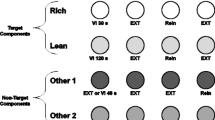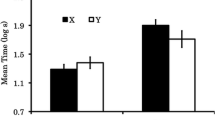Abstract
The effects of scopolamine hydrobromide on baseline extinction levels and spontaneous recovery were assessed. Rats were trained on one of four reinforcement schedules (CRF, FR 10, FR 20, FR 40) with either food or water reinforcement. Scopolamine increased response rates in extinction and spontaneous recovery following training on all four schedules when the reinforcer was water, but had no effect on responding previously maintained by food. The results are discussed in terms of the limitations of a general theory of a cholinergic system mediating all suppressed behavior and the effects of anticholinergic drugs on central thirst mechanisms and consummatory behavior.
Similar content being viewed by others
References
Bignami, G.: Anticholinergic agents as tools in the investigation of behavioral phenomena. In: Neuropharmacology. International Congress Series 129, H. Brill, ed., pp. 819–830. Amsterdam: Excerpta Medica 1967
Bohdanecký, Z., Jarvik, M. E.: Impairment of one-trial passive avoidance learning in mice by scopolamine, scopolamine methylbromide, and physostigmine. Int. J. Neuropharmacol. 6, 217–222 (1967)
Buresova, O., Bures, J., Bohdanecký, Z., Weiss, T.: Effect of atropine on learning, extinction, retention, and retrieval in rats. Psychopharmacologia (Berl.) 5, 255–263 (1964)
Carlton, P. L.: Some effects of scopolamine, atropine, and amphetamine in three behavioral situations. Pharmacologist 3, 60 (1961)
Carlton, P. L.: Cholinergic mechanisms in the control of the behavior by the brain. Psychol. Rev. 70, 19–39 (1963)
Carlton, P. L.: Brain acetylcholine and habituation. In: Progress in brain research, P. B. Bradley and M. Fink, eds. pp. 48–60. New York: Elsevier 1968
Carlton, P. L.: Brain acetylcholine and inhibition. In: Reinforcement and behavior, J. T. Tapp, ed., pp. 286–327. New York: Academic Press 1969
Carro-Ciampi, G., Bignami, G.: Effects of scopolamine on shuttle-box avoidance and go-no-go discrimination: responese-stimulus relationships, pretreatment baselines, and repeated exposure to drug. Psychopharmacologia (Berl.) 13, 89–105 (1968)
Goodman, L. S., Gilman, A.: The pharmacological basis of therapeutics. New York: Macmillan (1975)
Hanson, H. M., Witoslawski, J. J., Campbell, E. A.: Drug effects in squirrel monkeys trained on a multiple schedule with a punishment contingency. J. Exp. Anal. Behav. 10, 565–569 (1967)
Hearst, E.: Effects of scopolamine on discriminated responding in the rat. J. Pharmacol. Exp. Ther. 125, 349–358 (1959)
Heise, G. A., Laughlin, N., Keller, C.: A behavioral and pharmacological analysis of reinforcement withdrawal. Psychopharmacologia (Berl.) 16, 345–368 (1970)
Herblin, W. F.: Extinction reversal by scopolamine. Psychon. Sci. 13, 43–44 (1968)
Leaton, R. N.: Effects of scopolamine and methylscopolamine on brightness discrimination reinforced by opportunity for exploration. J. Comp. Physiol. Psychol. 68, 155–158 (1969)
Margules, D. L., Margules, A. S.: The development of operant responses by noradrenergic activation and cholinergic suppression of movements. In: Efferent organization and the integration of behavior, J. D. Maser, ed., pp. 203–228. New York: Academic Press (1973)
McKim, W. A.: The effects of scopolamine on the extinction of a continually reinforced response. Psychon. Sci. 20, 281–282 (1970)
Meyers, B.: Some effects of scopolamine on a passive avoidance response in rats. Psychopharmacologia (Berl.) 8, 111–119 (1965)
Meyers, B., Roberts, K. H., Riciputi, R. H., Domino, E. F.: Some of muscarinic blocking drugs on behavior and the electrocardiogram. Psychopharmacologia (Berl.) 5, 289–300 (1964)
Miczek, K. A.: Effects of scopolamine, amphetamine, and chlordiazepoxide on punishment. Psychopharmacologia (Berl.) 28, 373–389 (1973a)
Miczek, K. A.: Effect of scopolamine, amphetamines, and benzodiazepines on conditional suppression. Pharmacol. Biochem. Behav. 1, 401–411 (1973b)
Miczek, K. A., Lau, P.: Effects of scopolamine, physostigmine, and chlordiazepoxide on punished and extinguished water consumption in rats. Psychopharmacologia (Berl.) 42, 263–269 (1975)
Paul-David, J., Riehl, J. L., Unna, K. R.: Quantification of effects of depressant drugs on EEG activation response. J. Pharmacol. Exp. Ther. 129, 69–74 (1960)
Plotnik, R., Mollenauer, S., Milberg, L.: Scopolamine and food-reinforced behavior in the rat. Physiol. Psychol. 4, 443–446 (1976)
Rosić, N., Bignami, G.: Depression of two-way avoidance learning and enhancement of passive avoidance learning by small doses of physostigmine. Neuropharmacology 9, 311–316 (1970)
Samuel, G. K., Kodama, J. K., Mennear, J. H.: The effects of scopolamine and atropine and their quarternized salts on avoidance behavior in the monkey. Psychopharmacologia (Berl.) 8, 295–301 (1965)
Seybert, J. A., Gerard, I. C.: Acquisition and extinction effects of partial reinforcement under conditions of thirst motivation. Bull. Psychon. Soc. (in press, 1978)
Seybert, J. A., Gerard, I. C., Lawrence, W. T., Nash, S. W., Williams, C. L.: Effects of schedule and magnitude of reinforcement under conditions of thirst motivation. Learn. Motiv. 7, 559–570 (1976)
Stein, L.: Chemistry or purposive behavior. In: Reinforcement and behavior, J. T. Tapp, ed., pp. 328–355. New York: Academic Press 1969
Stone, G. S.: Effects of drugs on nondiscriminated avoidance behavior. I. Individual differences in dose response relationships. Psychopharmacologia (Berl.) 6, 245–255 (1964)
Vogel, J. R., Hughes, R. A., Carlton, P. L.: Scopolamine, atropine, and conditioned fear. Psychopharmacologia (Berl.) 10, 409–416 (1967)
Warburton, D. M.: Behavioral effects of central and peripheral changes in acetylcholinesterase systems. J. Comp. Physiol. Psychol. 68, 56–64 (1969)
Author information
Authors and Affiliations
Rights and permissions
About this article
Cite this article
Morley, B.J., Russin, R. The effects of scopolamine on extinction and spontaneous recovery. Psychopharmacology 56, 301–304 (1978). https://doi.org/10.1007/BF00432853
Received:
Accepted:
Issue Date:
DOI: https://doi.org/10.1007/BF00432853




